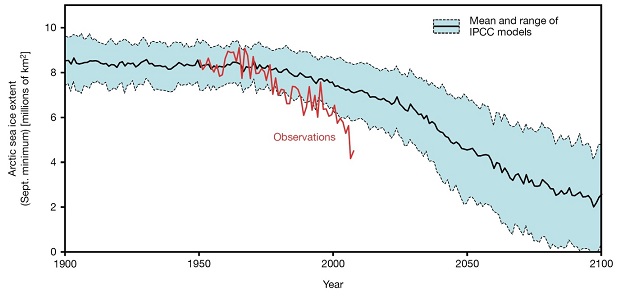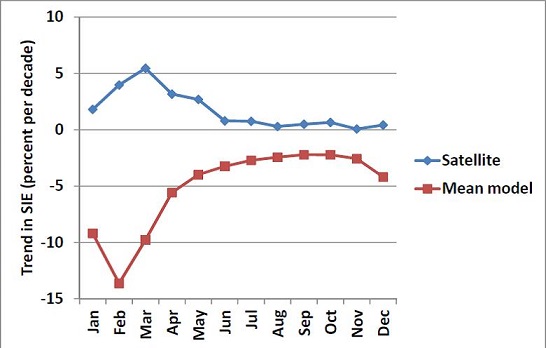Co-authored by John Norbury, University of Oxford
For most of us, a global warming of 1 degree C over the next 30 years or so is not a big worry -- more like moving house across a state closer to the equator, or descending several hundred feet nearer to sea level. But the distribution of water, and in particular rain, vitally affects the quality of life on our planet. Can mathematics help us to identify the warning signs, and the danger areas where such weather changes might occur?

The solid black line shows the average result of many forecasts for Arctic sea ice extent. The red curve shows the actual measurements, which get more accurate as more satellite observations are used. The salient point is that the forecasts predict the actual decrease in sea ice increasingly poorly from 1975 to the present day. How can math help us to improve these forecasts? (The Copenhagen Diagnosis, 2009: Updating the world on the Latest Climate Science. I. Allison, N. L. Bindoff, R.A. Bindschadler, P.M. Cox, N. de Noblet, M.H. England, J.E. Francis, N. Gruber, A.M. Haywood, D.J. Karoly, G. Kaser, C. Le Quéré, T.M. Lenton, M.E. Mann, B.I. McNeil, A.J. Pitman, S. Rahmstorf, E. Rignot, H.J. Schellnhuber, S.H. Schneider, S.C. Sherwood, R.C.J. Somerville, K.Steffen, E.J. Steig, M. Visbeck, A.J. Weaver. The University of New South Wales Climate Change Research Centre (CCRC), Sydney, Australia. Reproduced with permission.)
The solitary polar bear, stranded and helpless on a drifting block of ice, is a striking image from recent environmental press coverage. Its emotional pull has been followed up by many dramatic scenes of hurricanes, floods, droughts and forest fires -- these make us think hard about climate change. The message is that there is an increasing cost from severe weather that affects all of us on this planet. SKeptics, sometimes not so politely, remind us that if forecasters get it wrong seven days ahead, why should anyone believe the predictions for the global climate 25 years from now? It turns out that weather forecasting and climate prediction are two quite different mathematical problems.
In our new book Invisible in the Storm: The Role of Mathematics in Understanding Weather, we take readers behind the scenes to show how mathematics is being used to help verify and improve the supercomputer-based weather and climate forecasts. The book does this by describing and commenting on the past 350 years development of weather forecasting, bringing out the key ideas, the key practices, and how math has influenced the development of the subject.
Mathematicians now think about weather and climate in a new way. Our ever-changing weather can be visualized as a curve meandering through an abstract mathematical space of logically possible weather. Any one point of the curve corresponds to a particular state of the weather. The surprise is that the curve does not wander around randomly -- patterns emerge. Predicting changes in the weather for the week ahead involves working out if the curve will drift from one part of the pattern describing warm and dry weather, to another part describing wind and rain. Understanding climate change involves working out how the pattern itself will change, and this is necessary in planning future water supplies and flood protection. Irrespective of whether you believe that climate change is mainly affected by human activity or not, better prediction is essential.

The red curve shows the average of many predictions for sea ice extent in the Antarctic, except that here the monthly trend is shown for the period 1979-2005. The corresponding monthly trend as measured by the satellite observations is given by the blue curve. It shows an increase in the Antarctic sea ice extent for the same period. As the authors of this recent study comment, physical processes responsible for the increasing ice cover are at present not being simulated correctly. (© Professor John Turner, British Antarctic Survey, Cambridge, U.K.)
To understand the scientific basis of weather forecasting and climate prediction we need to understand the language that defines the problem, and that language is mathematics. Math enables us to confront our climate simulations with new sources of data, study weaknesses in our computer models, and identify ways of correcting the deficiencies. Very often, quite different phenomena, such as a hurricane and a jet stream, are described by the same math. As we describe in our book, incorporating the math into the computer models is leading to ever-more coherent pictures of how the entire Earth system will evolve in the future.
Atmospheric circulation -- the ceaseless winds that transport the warmed and moistened air around planet Earth -- is fundamental. In climate simulations, it is important to simulate the cycles of trace gases, such as methane, sulfur dioxide, carbon dioxide and ozone, together with their chemical interactions. The long-term change of these atmospheric constituents, including the movement of dust from arid regions, usually accompanies major climate change. Present-day science tries to understand, for example, how oceanic plankton blooms and loss of tropical rainforests modify the distribution of these gases.
It has been said by various authors that climate is what we expect, but weather is what we get. How can we use math and supercomputers to predict the change in variability of weather? Are droughts and storms getting more frequent and more severe? And where should we expect these more extreme bursts of weather to occur? Invisible in the Storm describes how math identifies constraints on the trillions of calculations that computers routinely carry out. The importance of these constraints is that they control the influence of random errors, and allow us to see what choreographs the myriad of local interactions to produce coherent, swirling cyclones -- and even superstorms such as Hurricane Sandy. This helps the computation to focus on what is predictable and stops us from being 'blown off course' by lack of perfect data. So math helps us decide between fact and fiction in weather and climate prediction.
Invisible in the Storm: The Role of Mathematics in Understanding Weather, by Ian Roulstone and John Norbury, published by Princeton University Press, 2013.
